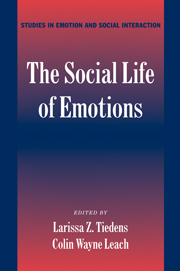Book contents
- Frontmatter
- Contents
- Acknowledgements
- List of Contributors
- The Social Life of Emotions
- Introduction: A World of Emotion
- PART I THE INTERPERSONAL CONTEXT
- PART II THE INTRAGROUP CONTEXT
- 6 Emotional Contagion
- 7 The Emotional Convergence Hypothesis
- 8 Emotional Variation in Work Groups
- 9 Inside the Heart of Emotion: On Culture and Relational Concerns
- 10 Objectification Theory and Emotions
- PART III THE INTERGROUP CONTEXT
- Index
- References
10 - Objectification Theory and Emotions
A Feminist Psychological Perspective on Gendered Affect
Published online by Cambridge University Press: 01 April 2011
- Frontmatter
- Contents
- Acknowledgements
- List of Contributors
- The Social Life of Emotions
- Introduction: A World of Emotion
- PART I THE INTERPERSONAL CONTEXT
- PART II THE INTRAGROUP CONTEXT
- 6 Emotional Contagion
- 7 The Emotional Convergence Hypothesis
- 8 Emotional Variation in Work Groups
- 9 Inside the Heart of Emotion: On Culture and Relational Concerns
- 10 Objectification Theory and Emotions
- PART III THE INTERGROUP CONTEXT
- Index
- References
Summary
In February 2002, the U.S. Food and Drug Administration approved the drug Botox, a diluted version of the neurotoxin that causes botulism, for the cosmetic purpose of removing wrinkles. Long in use by a mostly female consumer group – actresses and female TV personalities – as a quicker and easier way than plastic surgery to erase the signs of aging, Botox injections are now considered legally safe and can be marketed en masse to aging Americans in a fashion similar to the recent promotion of Viagra or Claritin. What is alarming about the potential widespread use, and the current popularity of it among women in the public eye, is its unavoidable side effect: loss of the ability to effectively communicate emotions via facial expression, particularly anger (see Friedman, 2002; Kuczynski, 2002).
Botox works by injection into the muscle behind one's wrinkles, and through local paralysis of that muscle, the wrinkles are smoothed. But because of that paralysis, one also can no longer use the muscles that caused the wrinkles – the lasting marks of repeated facial expressiveness – in the first place. So, in effect, having a Botox treatment not only makes it difficult for the recipient to demonstrate emotional feeling on the face, it also eliminates the evidence of years of emotions. About the common use of Botox by some women, The New York Times stated, “In a variation on ‘The Stepford Wives’ [a 1975 film in which “perfect” wives are revealed to be machines wearing mask-like disguises], it is now rare in certain social enclaves to see a woman over the age of 35 with the ability to look angry” (Kuczynski, 2002, p. A1).
- Type
- Chapter
- Information
- The Social Life of Emotions , pp. 203 - 224Publisher: Cambridge University PressPrint publication year: 2004
References
- 24
- Cited by



